“I am a soldier, not a butcher”: examining ‘Hellman of Hammer Force’
8th December 2021
One of the major highlights of the controversial 1970s comic, Action, ‘Hellman of Hammer Force’ was a unique series that followed a World War Two tank commander. But this wasn’t a brave British bulldog fighting the foreign enemy – he was German!
Continuing our series of short essays commissioned from selected comics critics that explore 2000 AD and the Treasury of British Comics’ latest graphic novel collections, Doris V. Sutherland takes a look at this groundbreaking series…
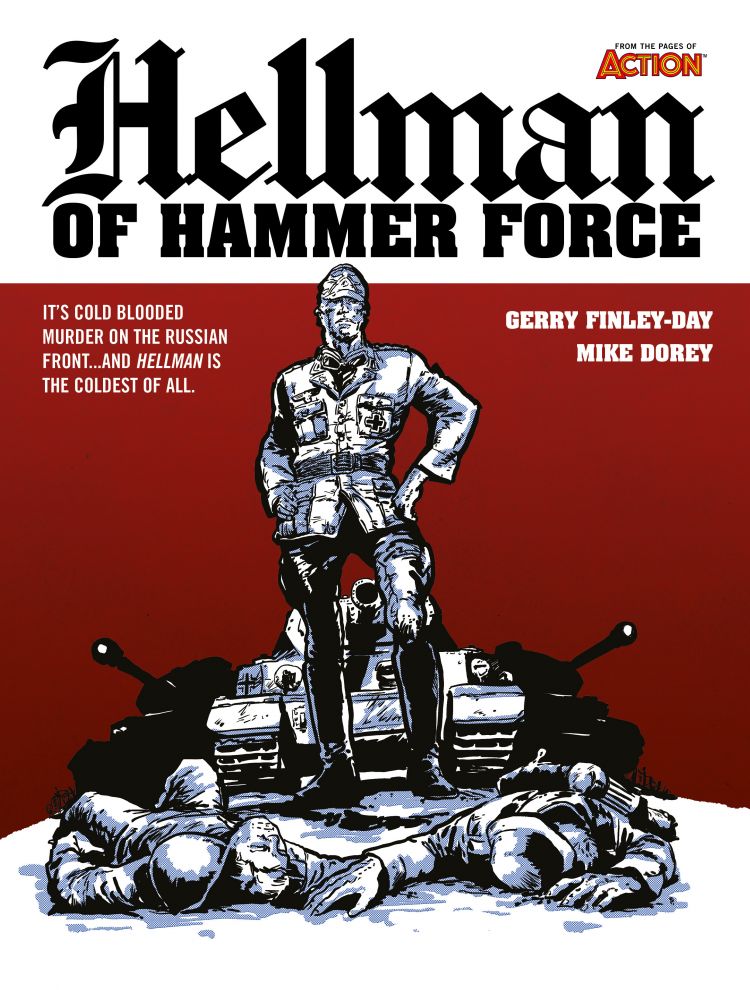
While Action sparked moral outrage during its heyday of 1976, much of its content today seems rather tame. After years of controversy over everything from violent video games to gangsta rap, a comic that drew its chief inspiration from Jaws and Rollerball seems positively quaint.
There is one exception, however. Action contained a certain strip that, had it made its debut today, may still have caused many a furrowed brow. That strip is ‘Hellman of Hammer Force’ — a World War II story in which the main character fights on the side of Germany. Scripted by Gerry Finley-Day with art by Mike Dorey and Alex Handerson, this provocatively-themed strip is now the subject of a Treasury collection.

The premise of ‘Hellman’ did not come out of the blue. Like much of Action, it has its roots in 1970s popular culture. The purportedly autobiographical novels of Sven Hassel, depicting life forced to fight beneath the swastika in a Danish penal battalion, were enjoying commercial success as paperbacks. A comic on a similar theme would have had clear marketplace potential.
Not that Hellman’s exploits have particularly strong aesthetic ties to Hassel’s bleak and brutal work. ‘Hellman of Hammer Force’ was never intended as an unflinchingly realistic examination of twentieth-century conflict; certainly, nobody will mistake it for ‘Charley’s War’. It belongs ultimately to the tradition of romanticised war comics that also gave us the likes of Commando, with derring-do very much the order of the day. Still, the premise of the series does force it away from simplistic us-versus-them flag-waving.
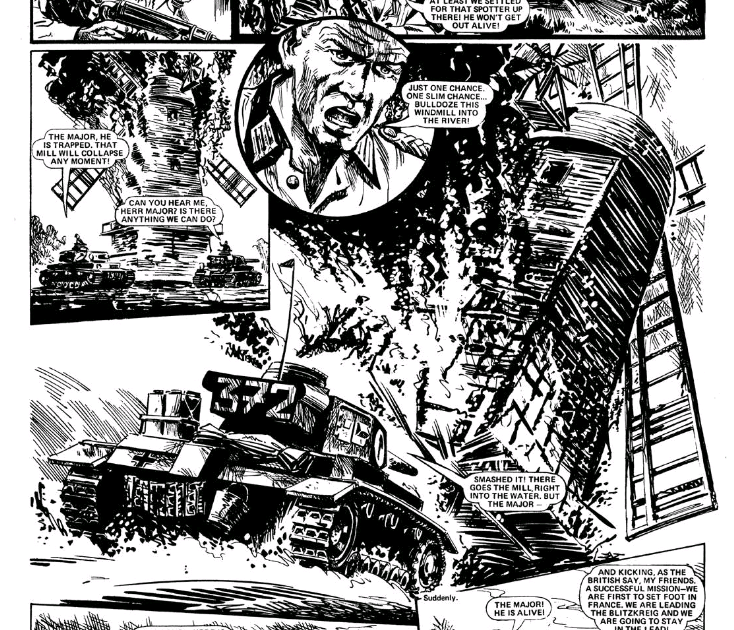
The strip’s main thrust is established early on via a top-of-the-page slogan: “He fought two wars — one against the allies, the other against his Nazi bosses.” While Hellman is fighting in Hitler’s army as a panzer major, he has no sympathy for the Fuhrer’s regime. A stickler for fair play, he wounds rather than kills his opponents where possible. This philosophy is contrasted with the likes of Hellman’s commanding officer Kastner, who shows no qualms about using the panzers to obliterate vastly overpowered soldiers.
“I am a soldier, not a butcher” protests Hellman in one story, when Kastner admonishes him for allowing defeated Englishmen to survive. Another instalment has Hellman disobeying a direct order by saving an injured enemy; he faces execution, but he receives unlikely salvation when a passing spitfire that guns down the officer before the order can be carried out.
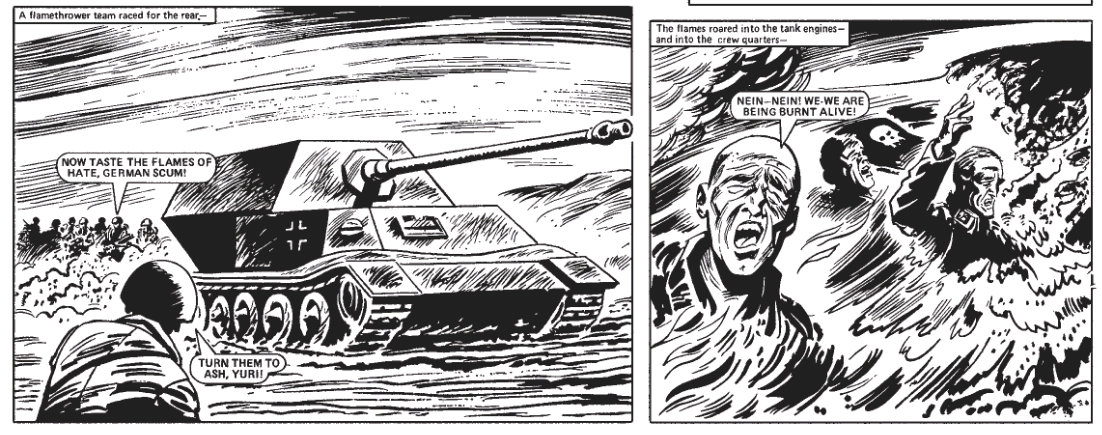
This scene is a good example of how the strip embraces the more fanciful aspects of old-school war comics. Likewise, many of the stereotypes found across the genre remain present and correct. Of the allies, the British are portrayed as the boldest: “Our blitzkrieg has completely shocked the enemy — even the British” says one of Hellman’s men. “The British I respect,” says Hellman elsewhere, “but the French bow to whatever wind blows strongest!” When the series introduces an allied officer as a recurring antagonist, it chooses not a Britisher but a boorish, bullying American named Colonel Rock: “We don’t pussyfoot around with stupid honour in this man’s army” declares the colonel. “You gangster!” responds Hellman in a thought balloon. “You throw away the rulebook like you throw away your cigar”.
Captured by Greeks, Hellman distracts them by throwing his medal to the ground, prompting them to scurry for the valuable trinket (“those Greeks value silver greatly… greedy fools! You deserve to lose!”) The German protagonist also resents his Italian allies, dismissing them as “cowards” and “of no use in a hard fight” — although the incident in which an Italian sacrifices his life to save him from a Sikh soldier’s razor-edged quoit perhaps prompts Hellman to reconsider this stance.
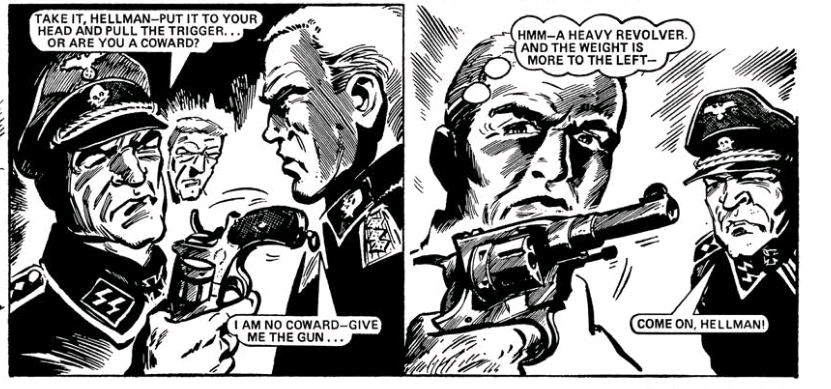
While it may be easy to scoff at certain aspects of ‘Hellman’, the strip does carry an undeniable atmosphere. Mike Dorey’s stark depictions of colossal tanks ploughing through the landscape provide an appropriately severe setting for the lantern-jawed anti-hero’s missions, particularly when the stories incorporate specific events from World War II.
We first meet Hellman on 1 May 1940 as the Hammer Force rolls into Belgium; later, the Battle of Dunkirk and the invasion of Greece play out against Hellman’s personal conflict with his superiors. Come 1941, Hellman is in North Africa; Erwin Rommel turns up as a background character, his disdain for “Nazi fools who know nothing about courage and soldiering” making him a kindred spirit to Hellman. Next, after charting conflict in Libya and El Alamein, the strip arrives in 1943, when Hellman’s anti-authoritarian leanings result in him being given a new command “in Germany’s most savage battleground… the Russian front.”
The strip introduces still more internal conflict when the Major is put in charge of a penal company. Although this plot element was likely inspired by Sven Hassel (the company is referred to as “the legion of the damned”, the title of Hassel’s first novel) the brutish convicts receive little of the sympathy that Hassel afforded his subjects “They loot the dead like vultures!” thinks an appalled Hellman. “For a moment they were soldiers — now they are back to scum!”
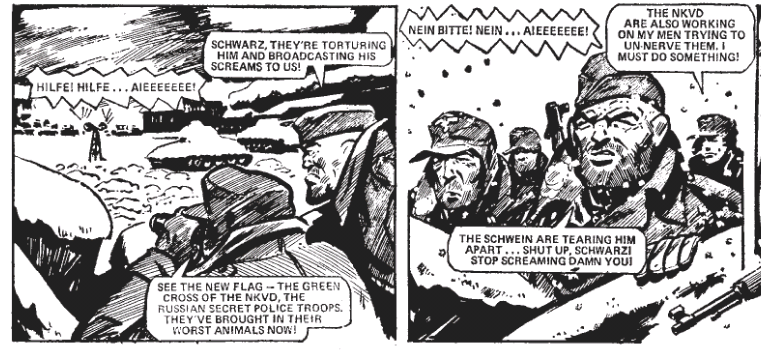
The Russian portion is where the strip becomes particularly bleak. Previously, the violence had been brutal, but portrayed in an indistinct manner: those dying were often obscured or shown from a distance. Now, we see in graphic detail such sights as men wailing in agony as they are roasted by flamethrowers, crushed by tank-treads or blown apart by landmines. Hellman is accompanied by the Waffen SS, who are even more sadistic than Kastner. In one strip Hellman plays Russian roulette with the SS leader, prefiguring The Deer Hunter.
‘Hellman of Hammer Force’ captures all of the straightforward appeal that made British war comics a thriving genre in their day, yet the grimness and squalor running through the stories really do add a new dimension. Read today, the strip becomes the best kind of throwback: the sort in which, for all of the old-fashioned aesthetics, the innovation remains palpable.
Doris V. Sutherland is the UK-based author behind the independent comic series Midnight Widows and official tie-ins for television series including Doctor Who and The Omega Factor. She has contributed articles to Women Write About Comics, Amazing Stories, Killer Horror Critic, Belladonna Magazine and other outlets.
All opinions expressed in this article are the author’s own and do not necessarily represent the opinions of Rebellion, its owners, or its employees.
